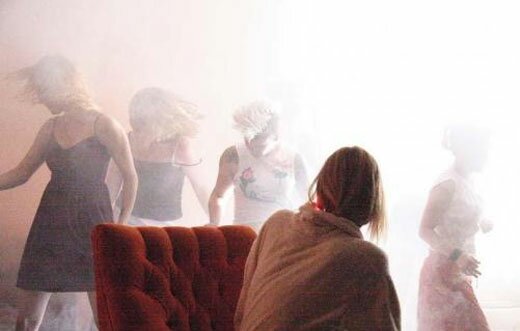Lynch’s Opus
Posted by ben on 20 Apr 2007 at 12:28 pm | Tagged as: responses/reviews, video/film

“Inland Empire” last night, not sure a traditional review is the most appropriate response (although that one will give you a good idea of what you’re in for).
But some thoughts. The red velvet curtains, the flickering lights that have haunted Lynch’s work since “Twin Peaks” (or earlier?) return. I think they still work — I think, in fact, they have developed since the Block Lodge. I wonder what this would look like to someone who hadn’t followed Lynch’s work. Are these images strengthened or dulled by a familiarity with Lynch’s vernacular?
To me, it’s not quite as crisp as “Mulholland Drive.” The contrast between acting and living isn’t as striking. There we see a reversal: the superficiality of life contrasted with the reality of acting. Here it all seems to blend and shift, there is rarely a moment in which you can say “ah, she’s acting” or “yes, this is real.” So “Mulholland Drive” remains for me the high point of Lynch’s ability to draw you in emotionally. There are more genuinely funny, scary, passionate moments there than in any of his other work (that I’ve seen).
For some reason, I kept thinking about Buñuel’s “That Obscure Object of Desire,” and how Buñuel used two actresses to play the same character in order to represent the shifts in identity. Lynch, instead, leaves the actress the same, and changes everything around her. Although he did use the Buñuel technique in “Mullholland Drive,” and I think (perhaps) at the very end of “Inland Empire.” If I’m reading this correctly, the shift in roles at the end of “Inland Empire” is a moment of freedom, whereas in “That Obscure Object of Desire” it seems to be a prison.
When the identities of the characters shift, relationships remain intact. I think this is an exploration of the tension between layers of identity. We may reconstruct our identities, but still relive the same relationships, until we transform ourselves on a deeper level. This is the “happy ending,” I think: she fundamentally changes her role in life, somehow.
Ultimately, though, this is a work of texture: visual, auditory, poetic textures contrasting and playing off of each other. Everything from the framing of the shots to the set design, lighting, soundtrack, dialogue and sometimes very subtle shifts in camera focus, give the sense of a development that is simply not narrative. There’s the suggestion of a narrative, of a developing plot, but in many ways it remains a very formal work. It is about the creation of mood, the development of character, the movement of story, but the moods are ambiguous, the characters are unstable, and the plot is pretty much non-existent. As Jason says, this does feel like the culmination of Lynch’s art, and I’ll add, probably about as good a definition of “post-modern” are you are likely to find anywhere.
PS. After the movie, we managed to get to Rock Bottom before Adult. took the stage. Their set, though short, was pretty heavy. They ditched their guitar player, so the synths moved to the forefront, which as Jeff DeCuir predicted at their last show in San Antonio, was a very good thing. I’m not sure if I just didn’t notice before, but their synth work is really interesting, coming from dance / industrial, but moving into abstraction. They can definitely be compared to Throbbing Gristle at times, but with those punkish vocals, the effect is pretty unique.
e bon ernest de terri et tori
UserLooking for Dragons?
Whitewall
Re:C – 2007/11/16 17:53 something else: i like the way madame writes on roberta smith.
there’s ms. roberta rainey in the air. a distant thunder. i like that. i love thunderstorms. whether they’re actually happening, or: when i can see them passing by in the distance. there’s anvenu.e air. a distant thunder. i like that. i love thunderstorms.
| | Please log in to post to the boards!
David O
User
Whitewall
Re:C – 2008/01/23 10:02 eating food in the brocery stLooking for Dragons?
he’ll look for a place to sit.” Stewart Copeland
| | Please log in to post to the boards!
l
UserDragons
Looking for Dragons? Find exactly what you want today.
Whitewall
Re:C – 2008/02/06 11:56 it’s the blood sugar,
User too Designs
Whitewall
Re:C – 2008/02/06 14:15 well, he always cries when I he’ll look for a place to sit.” Stewart Copeland
| | Please log in to post to the boards!